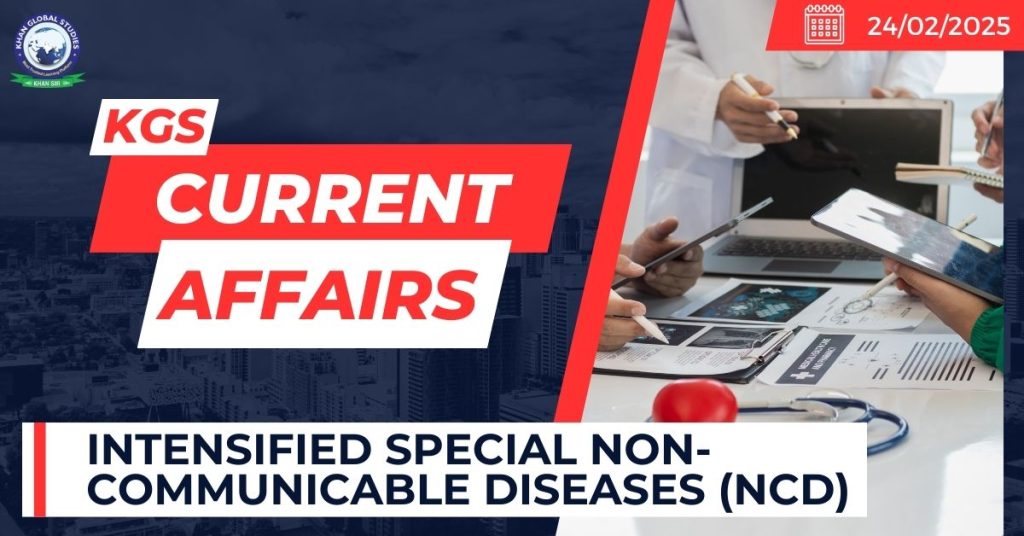Context:
Amid the rising burden of Non-Communicable Diseases (NCDs) in the country, the Union Ministry of Health & Family Welfare has launched an Intensified Special NCD Screening Campaign.
More on the News
- The campaign ensures 100% coverage of all individuals aged 30 years and above for prevalent NCDs, including Diabetes, Hypertension, and three common cancers—Oral, Breast, and Cervical.
- It will be executed across Ayushman Arogya Mandirs (AAMs) and various healthcare facilities nationwide, under the administrative control of the National Programme for Prevention and Control of Non-Communicable Diseases (NP-NCD).
Key Highlights of the Campaign

- Door-to-door outreach: Trained ASHAs, ANMs, and frontline workers will conduct community visits to ensure maximum screening coverage, reaching individuals in their homes.
- Essential Supplies: States and Union Territories (UTs) will guarantee the availability of essential medical supplies at all healthcare centres.
- Real-Time Monitoring: Data on screening, treatment, and follow-ups will be uploaded daily on the NP-NCD Portal to ensure transparency and accountability.
- Multi-level coordination: Nodal officers will be appointed at facility, block, district, and state levels to facilitate seamless execution of the campaign.
- Daily Progress Review: States and UTs will provide updates to the Ministry by 6 PM daily, allowing for continuous monitoring and technical support.
About Non-Communicable Diseases (NCDs)
- NCDs also known as chronic diseases, are long duration caused by genetic, physiological, environmental and behavioural factors, leading to long-term health consequences and often create a need for long-term treatment and care.
- The main types of NCDs are cardiovascular diseases (such as heart attacks and stroke), cancers, chronic respiratory diseases (such as chronic obstructive pulmonary disease and asthma) and diabetes.
- These chronic diseases are not transmissible from one person to another.
NTDs Scenario in India
- India experiences the world’s absolute burden of at least 11 NTDs, including hookworm, dengue, lymphatic filariasis, leprosy, kala-azar, and rabies, representing the highest number of cases worldwide.
- India leads the world in terms of the total number of cases for each of the primary NTDs.
- India successfully eradicated trachoma by 2017. Similarly, yaws and guinea worm were also eliminated.
- India has a target of eradicating lymphatic filariasis by the end of 2027.
- India officially eliminated leprosy in 2005, reducing its prevalence rate to 0.72 per 10,000 people at the national level.
Steps taken to reduce Non-Communicable Diseases by Government
Population Based Screening (PBS) for common NCDs was launched in year 2016 which includes screening of individuals of 30 years and above age group for five common NCDs i.e., Hypertension, Diabetes, and Cancers of the oral cavity, cervix and breast.
The National Health Policy (NHP), 2017 highlighted the need to halt and reverse the growing incidence of chronic diseases, including NCDs.
The Central Government implements the Strengthening of Tertiary Cancer Care Centres Facilities Scheme in order to enhance the facilities for tertiary care of cancer.
Open-Source Drug Discovery (OSDD): Led by CSIR, it fosters collaboration towards discovering novel therapies for NTDs by providing a platform where researchers can collectively address complex challenges in drug discovery.
The road map targets for 2030: These targets are in line with the Sustainable Development Goals and WHO’s 13th General Programme of Work:
- 90% fewer people requiring interventions against NTDs.
- 75% fewer NTD-related Disability-adjusted life years (DALYs).
- 100 countries achieving elimination of at least 1 NTD.
- Eradication of 2 NTDs – dracunculiasis and yaws.

